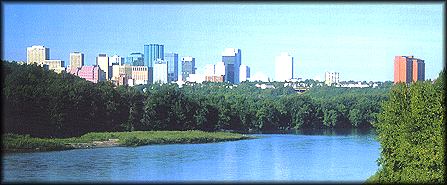
The Downtown Fly Fisher: Edmonton
Variety is the Spice - of Fly Fishing On the Prairie
Text by Roman Scharabun
Photos by Duane S. Radford
Although parts of Alberta are famous for their incredible fly
fishing opportunities, Edmonton is not usually regarded as one of them.
Unlike Calgary, its arch-rival to the south, it has not been blessed with
the Bow running through it. Historically, Edmonton was the "Gateway
to the North" and the "Klondike," and the summer celebration of Klondike
Days is a popular tourist attraction, but flyfishing?
The city also hosts the largest Fringe Festival (alternate theatre)
in North America, but you won't find anyone giving a casting demonstration
there. The well known West Edmonton Mall, with its hundreds of shops
and displays, has a fleet of submarines that take shoppers on underwater
tours, but no one will be seen roll casting there. And although golfers have
to contend with ponds and canals of all sorts (some of which have incredible
Callibaetis hatches), not a single fly fisher will be found stalking their banks.
In 2001, the city will be host to the world Track and Field Championships.
Do you think distance casting will be one of the events? Not likely!
Nevertheless, among all these activities and achievements a veiled jewel awaits.
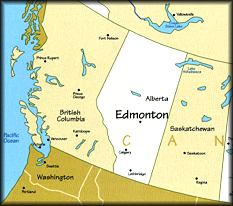 Edmonton is situated on the banks of the North Saskatchewan River, which
winds its way through the heart of the city. The river's source is the
Saskatchewan Glacier in the Rockies and from there it flows east
ultimately joining the South Saskatchewan River near Prince Albert,
Saskatchewan, and finally emptying into Hudson's Bay. As Edmonton
grew from a primitive settlement to a burgeoning modern city of 650,000
the demands could have easily laid waste to the river valley, but city planners
had the foresight, not only to protect, but to enhance the habitat, and
although the water is always turbid to some degree, it provides some
unexpectedly excellent fishing.
Edmonton is situated on the banks of the North Saskatchewan River, which
winds its way through the heart of the city. The river's source is the
Saskatchewan Glacier in the Rockies and from there it flows east
ultimately joining the South Saskatchewan River near Prince Albert,
Saskatchewan, and finally emptying into Hudson's Bay. As Edmonton
grew from a primitive settlement to a burgeoning modern city of 650,000
the demands could have easily laid waste to the river valley, but city planners
had the foresight, not only to protect, but to enhance the habitat, and
although the water is always turbid to some degree, it provides some
unexpectedly excellent fishing.
Reading the River
In Edmonton (and for many miles upstream) the river is slow moving but
very powerful. The speed of the river current varies between 2km and 8km
an hour, peaking in June and July, which restricts wading opportunities.
However, there are exposed gravel bars that can be reached from the
shore during normal flows, which provide some very exciting fishing
for goldeye, mooneye and mountain whitefish. A boat is needed to
cover places inaccessible to wading, but avoid float tubes and pontoon
boats. This is a big, powerful river, so go with the "Real McCoy" such
as a drift boat. Aluminum boats 14' and longer can also be used, but
must be equipped with a motor with enough power to handle that 8
km/hr current.
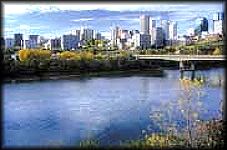
The N. Saskatchewan River is home to walleye, sauger, pike, goldeye
(and less frequently mooneye) and mountain whitefish. There are
sturgeon in the river as well, but fly fishing for them is really a stretch
of the imagination - although stranger things have happened.
The odd brown trout has also been caught, but the numbers are quite
low and the likelihood of success is marginal. Several hundred browns
were apparently released in the Devon area upstream of Edmonton a
decade or two ago, but, although the occasional specimen is caught, it
does not appear that the planting has been successful even though suitable
habitat is present in the area. The main target species for the fly fisher are
goldeye, whitefish and pike.
Reading a big, even-flowing river such as the North Saskatchewan can
be a challenge. It helps to simplify the situation by treating the river as
two rivers - one along each bank - and to explore the areas you'd expect
to find fish holding in smaller waters. Let's face it - fish are
fish regardless of species, and they require essentially the same basic
conditions for survival: (1) protection from the current, (2) protection
from predators, (3) access to a reliable food source and (4) adequate
water oxygenation. Sounds a lot like what you would look for when
trout fishing, doesn't it?
Look for current seams (where slow and fast water meet), in-stream
obstructions such as sunken logs (this isn't a mountain river so you
won't find much in the way of boulders), and cut-banks. Overhanging
vegetation and gravel bars can be particularly productive, especially
for goldeye. The mouths of tributaries, including stormwater outflows,
such as White Mud Creek and Mill Creek, are also good. Finally,
accessible bridge pilings, deep holes, wingdams, rock piles and side
eddies are also prime holding areas. As bank access is difficult, these
structures are best explored from the vantage points of bridges and
riverside hills, but a boat is necessary for full access.
Fishing the River
Goldeye are the main target for the dry fly on the North Saskatchewan.
A 9-foot, 3-4 wt rod will do very nicely. A double tapered fly line is a
good choice since you may find yourself roll casting frequently and this
can be difficult with a weight forward line. Fly selection is not critical
and usually an olive bodied Elk Hair Caddis in size 14-16, attached to
a 5x tippet, will bring these fish up. Skating these at the heads and tails
of shallow flats, over gravel bars, or alongside cut banks is the most
productive technique. Fighting a goldeye is an interesting experience
due to their body shape. They are rather thin but broad vertically. When
hooked they often turn their bodies sideways in the current, substantially
increasing resistance.
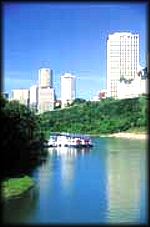 I recall one warm August evening driving down a truck trail west of
Edmonton. The trail came to an end at an old gravel dig. I parked there,
strung up my rod and walked about a hundred yards to the river. The high
cirrus clouds were backlit orange by the failing light as I cast a #16 Royal
Wulff up to the head of the gravel bar ,and started stripping the line in
gently. Just as the fly came even with me, it disappeared in a gentle swirl.
Five minutes later I was holding a silvery, fourteen-inch goldeye. He had
used the current expertly and had made me use all my skill just to land him.
They truly are fine fighting fish.
I recall one warm August evening driving down a truck trail west of
Edmonton. The trail came to an end at an old gravel dig. I parked there,
strung up my rod and walked about a hundred yards to the river. The high
cirrus clouds were backlit orange by the failing light as I cast a #16 Royal
Wulff up to the head of the gravel bar ,and started stripping the line in
gently. Just as the fly came even with me, it disappeared in a gentle swirl.
Five minutes later I was holding a silvery, fourteen-inch goldeye. He had
used the current expertly and had made me use all my skill just to land him.
They truly are fine fighting fish.
The same equipment can be used on mountain whitefish, but for these,
subsurface patterns such as the Gold-ribbed Hare's Ear, Pheasant Tail,
and the Deep Diving Sparkle Caddis are the most effective. But if the
whitefish happen to be rising while you're there in the evening, then try
a brown bivisible or the reliable Adams in sizes 16-18. Take care in
fighting these fish, as the hook can easily be dislodged from their small,
delicate mouths.
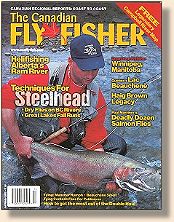
For pike and walleye, an 8 weight outfit is more suitable. Although
walleye seldom take a surface fly, pike will readily, particularly if it's
early in the season. Strip large poppers or bombers (size 2/0 to 2) or
hopper patterns in size 6-8 to bring these toothed critters up from
holding lies along the bank. For sub-surface patterns the perennial
woolly bugger is very tough to beat, as is the Bunny Bug. Remember
you'll also need to set yourself up with a much heavier leader if you're
after pike or suffer a lot of break-offs. ~ Roman Scharabun
Continued next time!
|





